In theory, horror shouldn’t be an easy fit for stories of ten pages or less. For a narrative to be truly scary or disturbing, the stakes should be painstakingly set up, the atmosphere should breathe, the fearful anticipation should be allowed to build up, and each shock should be earned.
In practice, comic books perfected this type of short story several decades ago, with horror anthologies becoming a staple of the medium…
For this Halloween, here are ten tales that brilliantly assault readers with striking images while using text to stretch out the tension as much as possible:
‘Dream of Doom’ (originally published in Weird Science #12, cover-dated May-June 1950), by Harry Harrison (script, pencils), Wally Wood (inks), Marie Severin (colors), and Jim Wroten (letters)
I’ll try not to overuse the adjective ‘nightmarish’ but in this case it fits like a glove. ‘Dream of Doom’ plays with a recognizably eerie sensation as it follows Arthur Bristol, an artist who is never quite sure whether he is dreaming or awake. We share his anxiety, as he is constantly jerked into new realities (including a meeting at a clear stand-in for the EC offices – one of several in-jokes in the story). Adding to the unsettling mood, the art is full of surreal, disconcerting touches, like the panel where the protagonist’s face is drowned by phantasmagorical phone ringing or the mise en abyme moment when a character holds a comic book page that looks like the one we are holding ourselves… Even Jim Wrotten, whose lettering tended towards bland typeset fonts, gets in on the act by conveying some inspired moments of shouting.
‘Carrion Death!’ (originally published in Shock SuspenStories #9, cover-dated June-July 1953), by Bill Gaines, Al Feldstein (plot), Al Feldstein (script), Reed Crandall (art), Marie Severin (colors), and Jim Wroten (letters)
Reed Crandall’s first story for EC Comics is a brutal, gruesome affair, even by today’s standards. With a tinge of noir, ‘Carrion Death!’ follows a crook on the lamb for whom things just keep on getting worse. The comic spirals through various kinds of violence, from a car crash to a strangling, from corpse mutilation to starvation, from the aggressive heat of the sun to the threat of flesh-eating vultures… Crandall’s meticulous attention to detail makes the whole thing look unbearably realistic, so that your face reading it probably mirrors the protagonist’s own panicked expression. To top it all off, Marie Severin’s colors conjure up the desert’s bleak aridness and shifting temperatures while Al Feldstein’s narration is almost poetically macabre.
‘The Worm Turns’ (originally published in The Thing #15, cover-dated July-August 1954), by Steve Dikto (art) and Charlotte Jetter (letters)
I don’t know who wrote this beauty, but it was clearly someone in tune with the 1950s’ wave of sci-fi horror, where giant, destructive creatures and scientific experiments gone awry acted out the worst fears of the early atomic era (although the idea of a mad doctor playing god goes back to Frankenstein, name-checked halfway through). ‘The Worm Turns’ is full of sick moments and a shockingly expanding body count, culminating in a resolution that somehow feels both hopeful and frightening. Yet the big draw is a young Steve Ditko’s artwork: not only does Ditko make the protagonist look truly menacing and twisted, but his rendition of the genocidal worm’s callous eyes, drooling mouth, and tubular, starkly inhuman body almost makes one afraid of even touching the drawings on the page…
‘Murder Dream’ (originally published in Tales from the Crypt #45, cover-dated December 1954-January 1955), by Carl Wessler (script), Bernie Kriegstein (art), Marie Severin (colors), and Jim Wroten (letters)
This stream-of-consciousness narrative about a man plagued with nightmares about the apparent murder of his wife is an effective vehicle for Bernie Kriegstein to indulge in the kind of aesthetic experimentation he often sought, breaking loose in hallucinatory, deliberately disorienting Freudian dream sequences. You may find the ending a cheat or a superb twist, but in any case you’re bound to be struck by the last panel’s cruel, horrifying rawness.
‘The Demon Within!’ (originally published in House of Mystery #201, cover-dated April 1972), by Joe Orlando (plot), John Albano (script), and Jim Aparo (art, letters)
Probably the most acclaimed comic on the list, this tale about a little boy who can turn into a scary monster at will won the Shazam Award for Best Individual Short Story and has been reprinted a number of times. The impact of ‘The Demon Within!’ derives from its Twilight Zone-ish sleight of hand – rather than the monster, the most terrifying force ends up being society itself… What truly scares the boy’s nuclear family is their possible loss of respectability and public standing in the community. Add to this Jim Aparo’s naturalistic depiction of suburbia, coupled with his signature tilted art and letters. Suitably, the creepiest images don’t even feature the monster – like the one with the doctor washing his hands before surgery at the Caufield hospital (a name reminiscent of Holden Caulfield, reinforcing the themes of loss of childhood innocence and repression of irreverence), not to mention the unforgettable final panel (a resolution that disturbingly evokes current parental strategies).
‘In the Shadows of the City’ (originally published in Haunt of Horror #1, cover-dated May 1974), by Steve Gerber (script) and Vicente Alcazar (art)
Always one to push the medium, writer Steve Gerber provides not so much a story as an exercise in instilling dread, upsettingly exploiting the mid-70s paranoia over urban crime (especially in NYC) by nudging readers’ fear of sudden, random, violent death. ‘In the Shadows of the City’ revolves around a psychopath obsessed with murder fantasies, somehow able to project them to potential victims. While the various POV shots make us share his horrific visions, the narration addresses us directly, breaking the fourth wall. The result is a diabolical comic that explicitly threatens its audience.
‘Deathwatch’ (originally published in Haunt of Horror #4, cover-dated November 1974), by Gerry Conway (script) and Young Montano (art)
Although nuclear war-themed post-apocalyptic fiction tends to be labelled as sci-fi, there is a reason this story was published in Marvel’s mature readers’ horror magazine. ‘Deathwatch’ is less concerned with realistically speculating about the specific outcome of an atomic exchange (here presented as catastrophic event, albeit not an end-of-the-world scenario) than with the horror that such an exchange could actually take place *at all*, hence its setting in a near future. We follow the aftermath through the perspective of Craig Macintosh, a soldier stationed in Alaska who, having survived the strike, comes to a life-changing realization about the conflict. Ultimately, Gerry Conway’s powerful agitprop script should be read as an indictment, not just of the Cold War, but of the military establishment itself, a message that cannot be delinked from the events in Vietnam at the time.
‘Clarice’ (originally published in Creepy #77, cover-dated February 1976), by Bruce Jones (script) and Bernie Wrightson (art)
Bruce Jones’ devastating gothic poem about a man in a cabin recalling his lover who died in the snow is morbidly beautiful and melancholic. The extra punch comes from the fact that ‘Clarice’ isn’t just about mourning, but also about guilt. Moreover, pleasingly, Bernie Wrightson’s haunting art doesn’t stick to literal illustrations – instead, it shows another layer of the story that you can take as either fantastical or metaphorical.
‘In Deep’ (originally published in Creepy #83, cover-dated October 1976), by Bruce Jones (script) and Richard Corben (art, colors)
Bruce Jones revisited some of the themes of ‘Clarice’ in this harrowing tale about a couple adrift at sea, where they have to deal with the merciless sun, the dangerous waters, the unavoidable tiredness, and, of course, the hunger and thirst. The great Richard Corben, who drew and colored ‘In Deep,’ delivered some truly desolate visuals as well as a couple of startlingly gory sequences. This is the stuff traumas are made of.
‘Done Deal’ (originally published in 2000 AD #1886, cover-dated June 2014), by Alec Worley (script), Tom Foster (art), and Ellie De Ville (letters)
Finally, a bit of urban horror with a more modern vibe worthy of the New Weird school of fiction. A tale of two teens with a comatose mother, ‘Done Deal’ effectively uses shorthand and familiarity to establish – in just *four pages* – both a slice of realistic family drama and a sinister revelation.

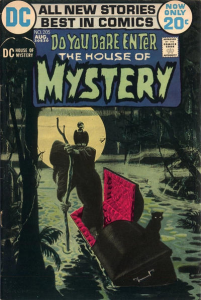
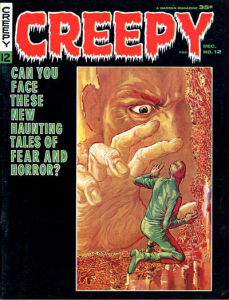
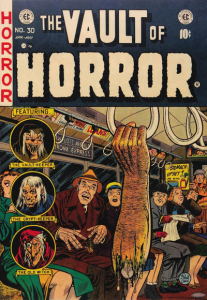
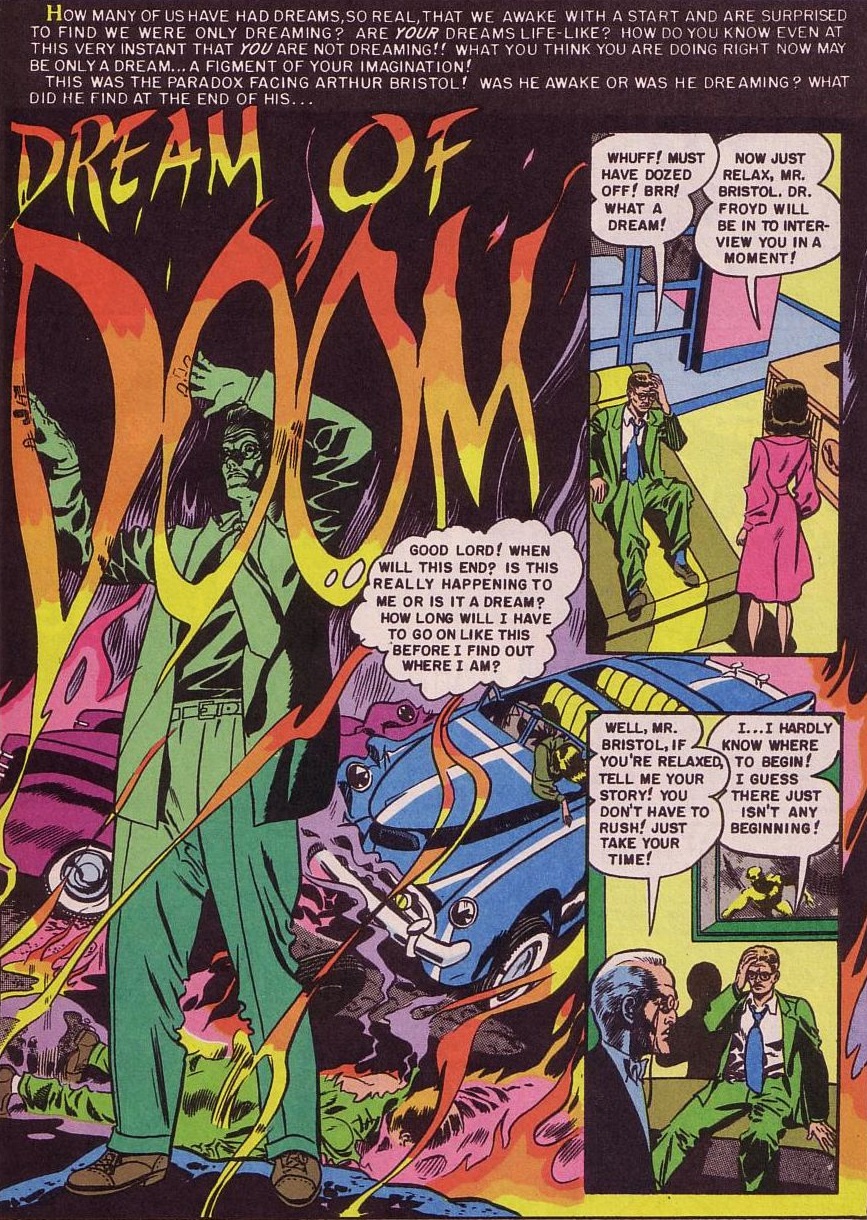
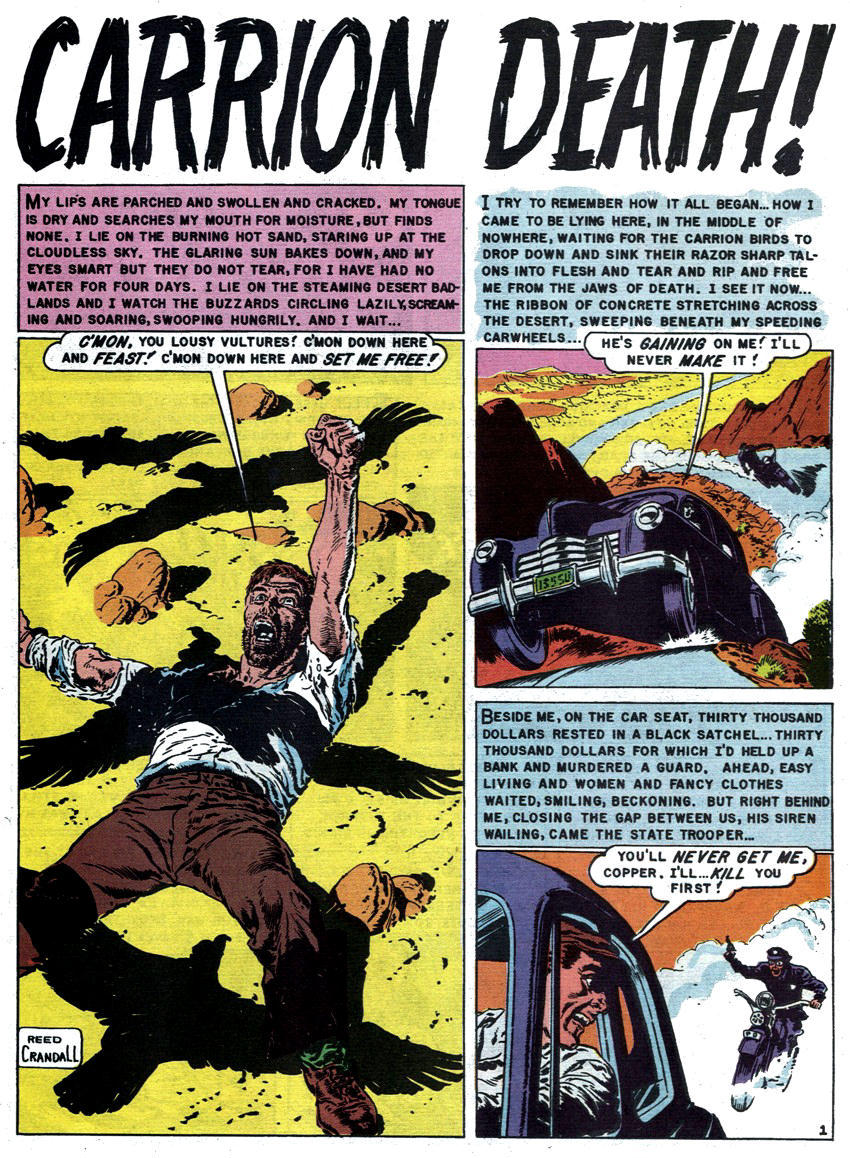
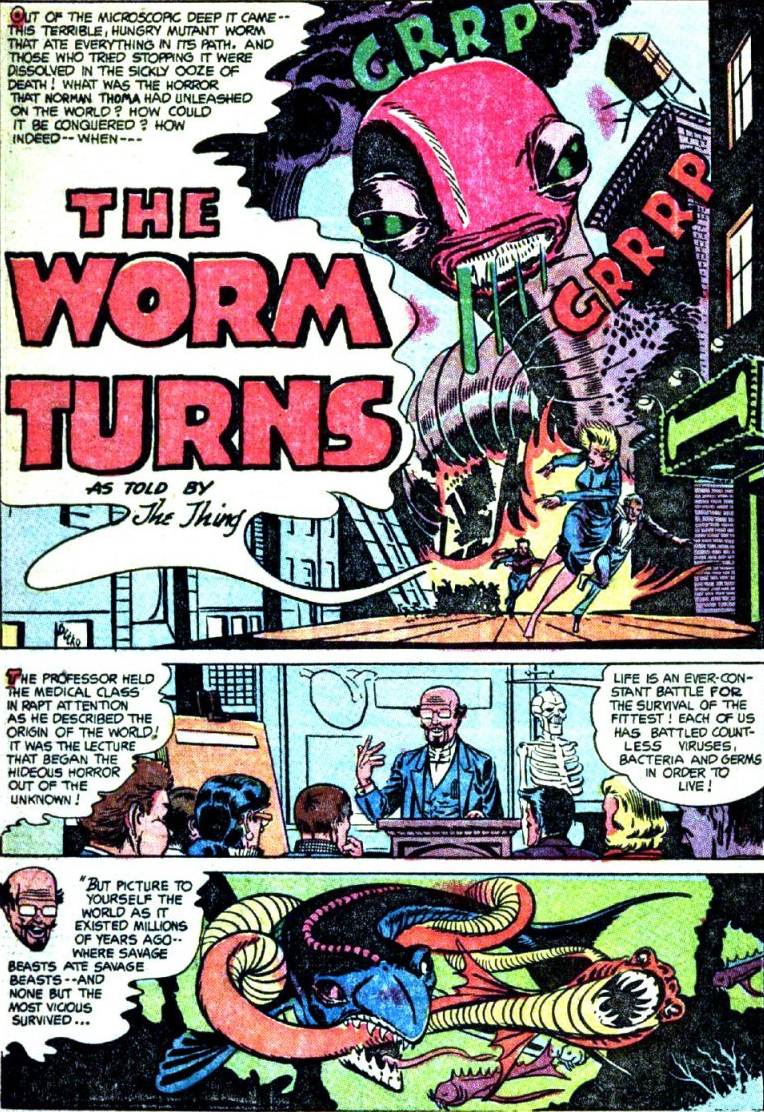
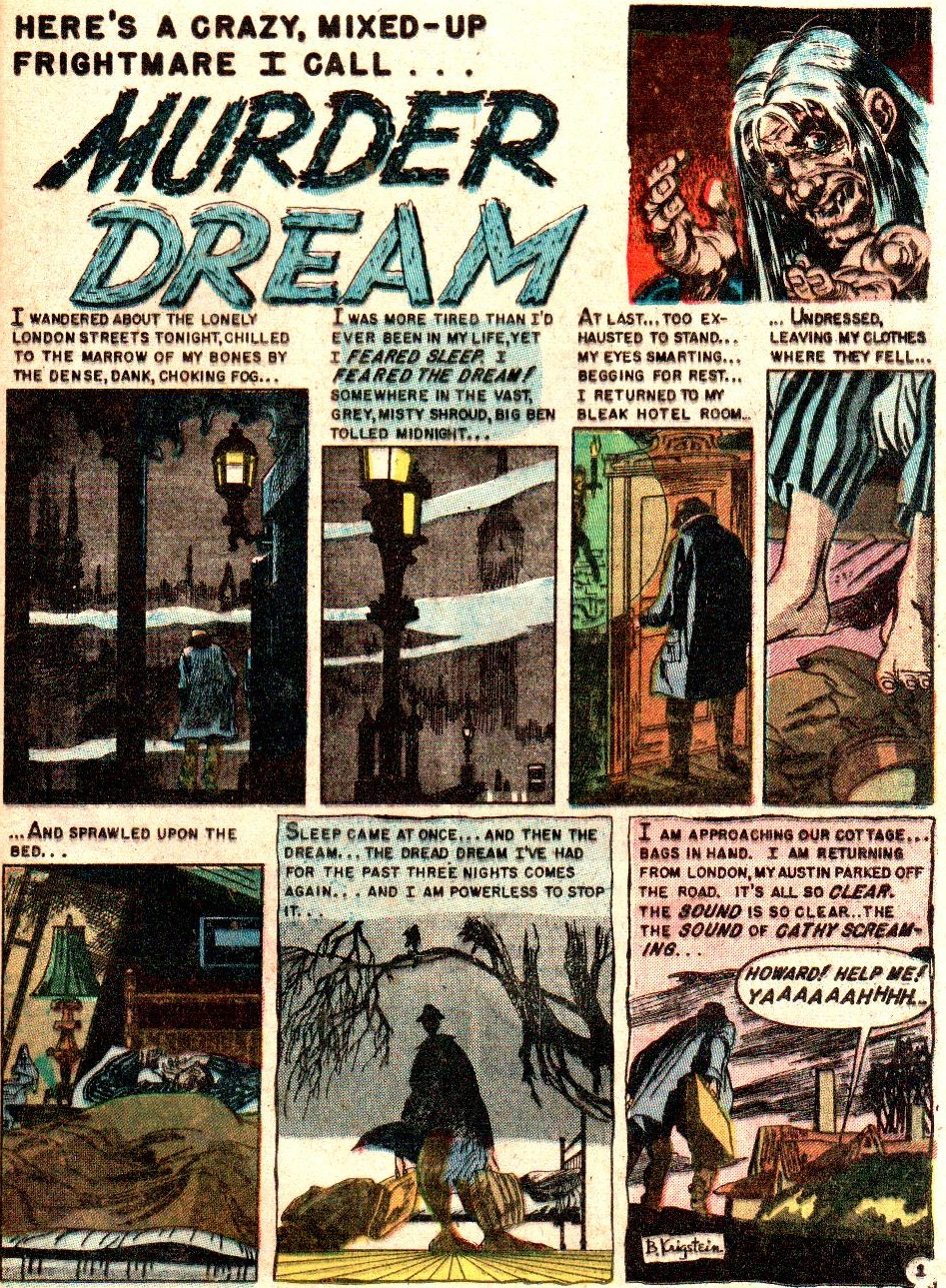
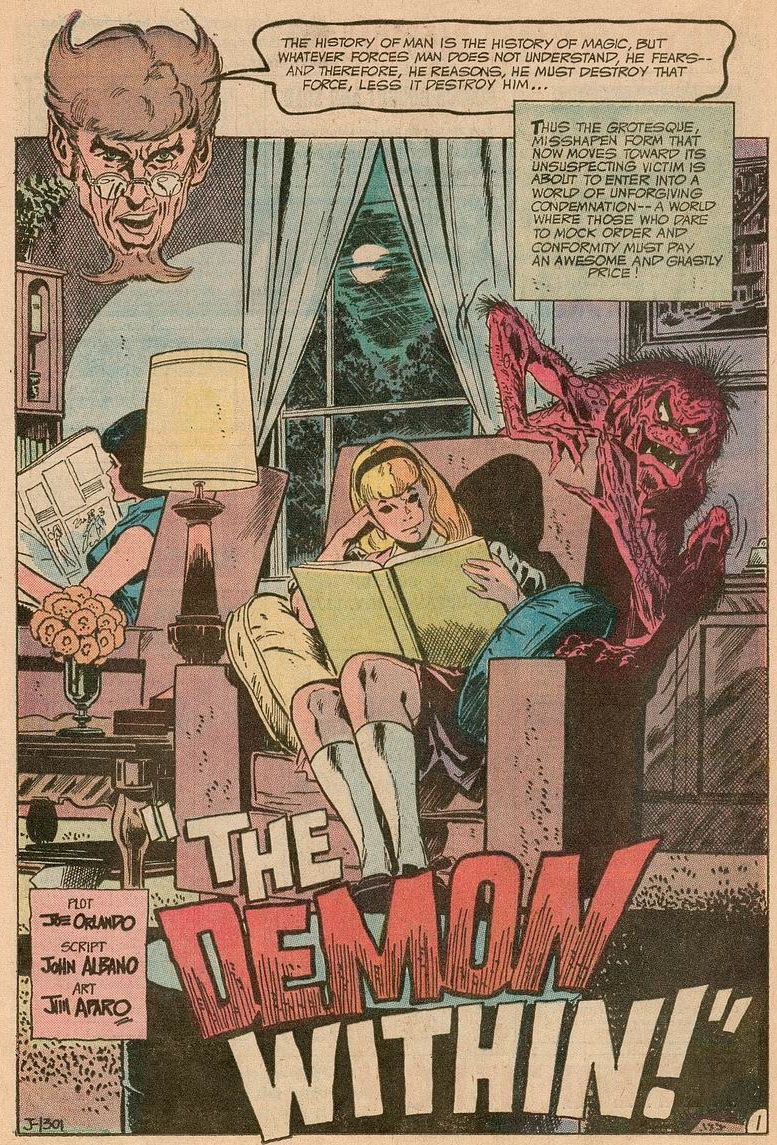
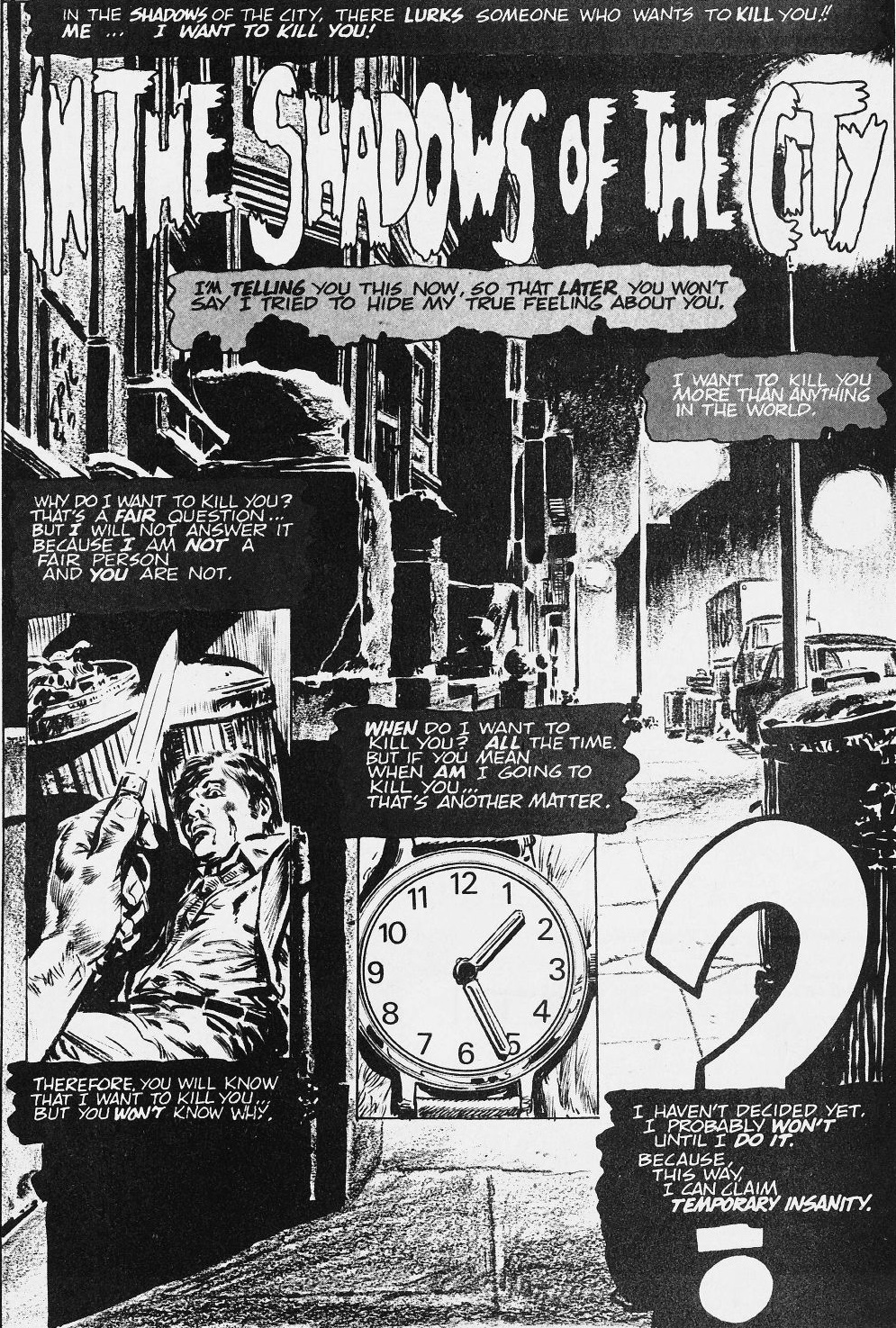
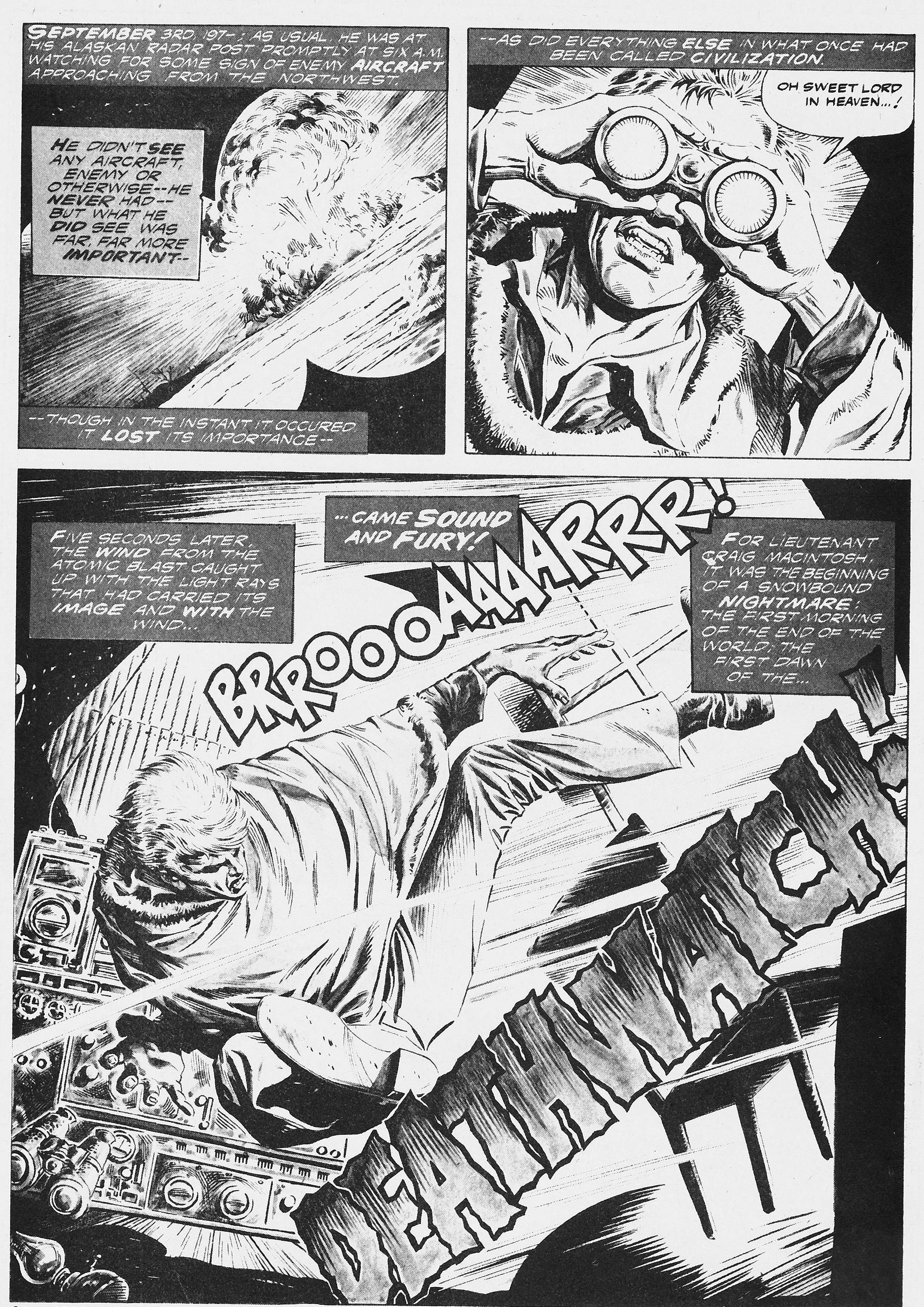
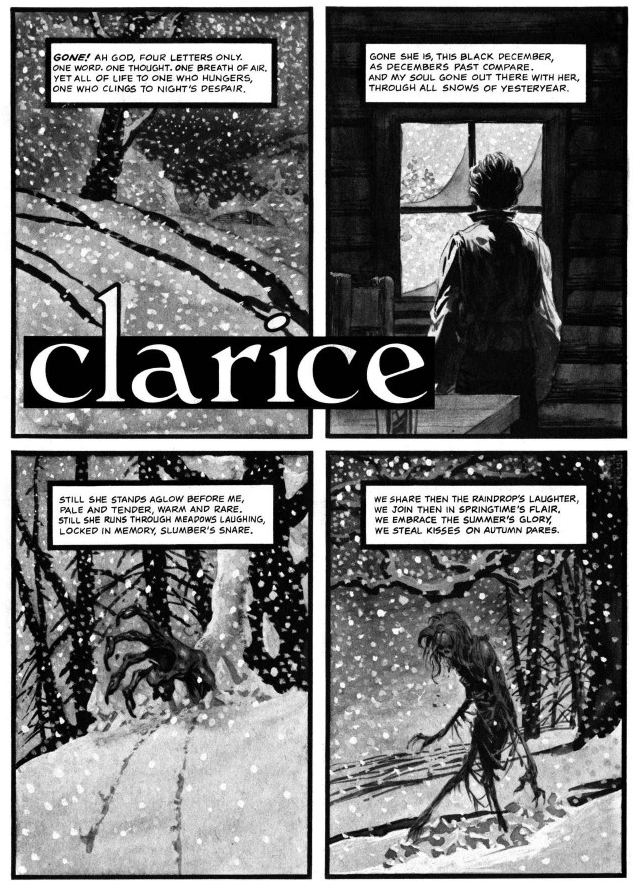
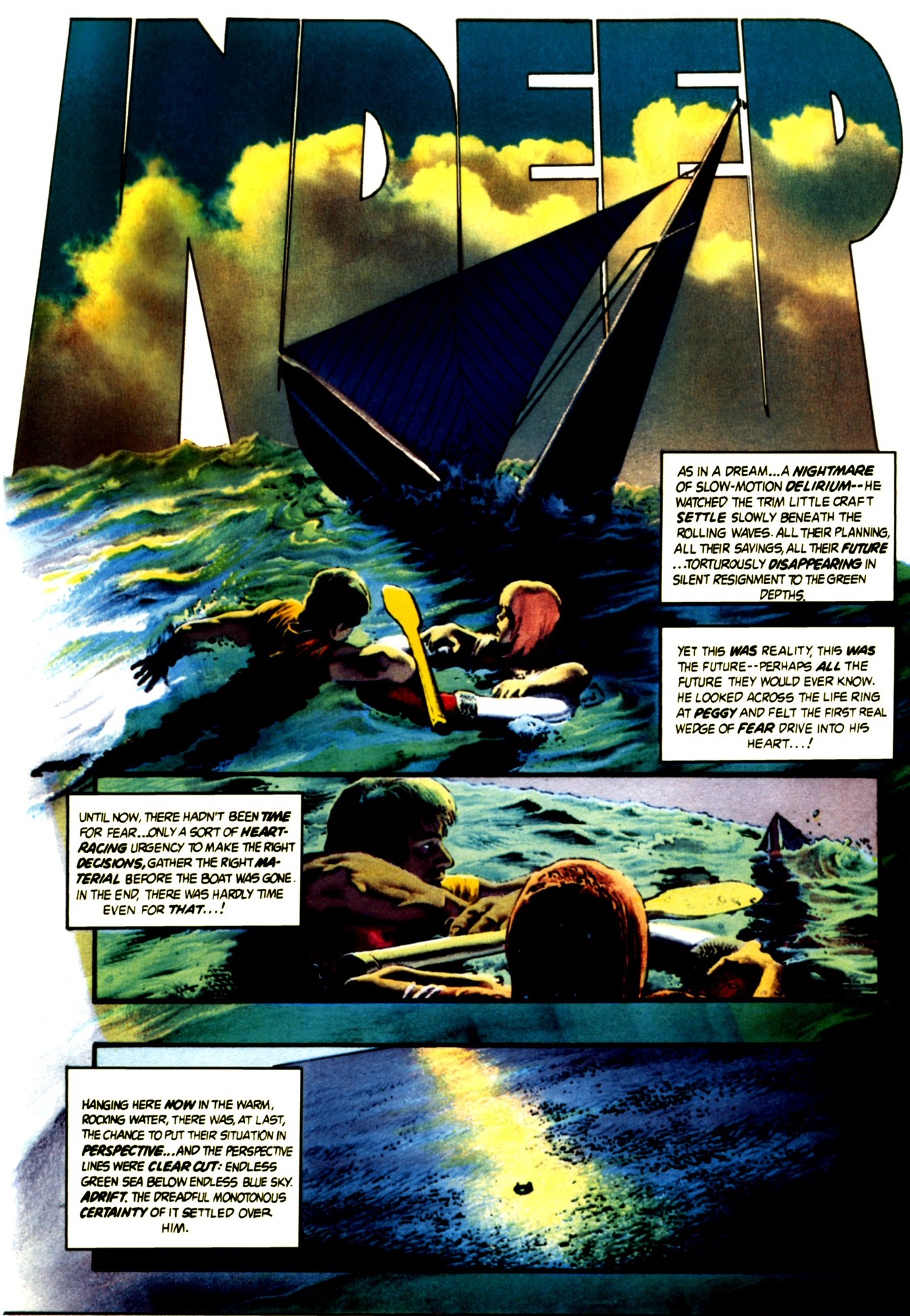
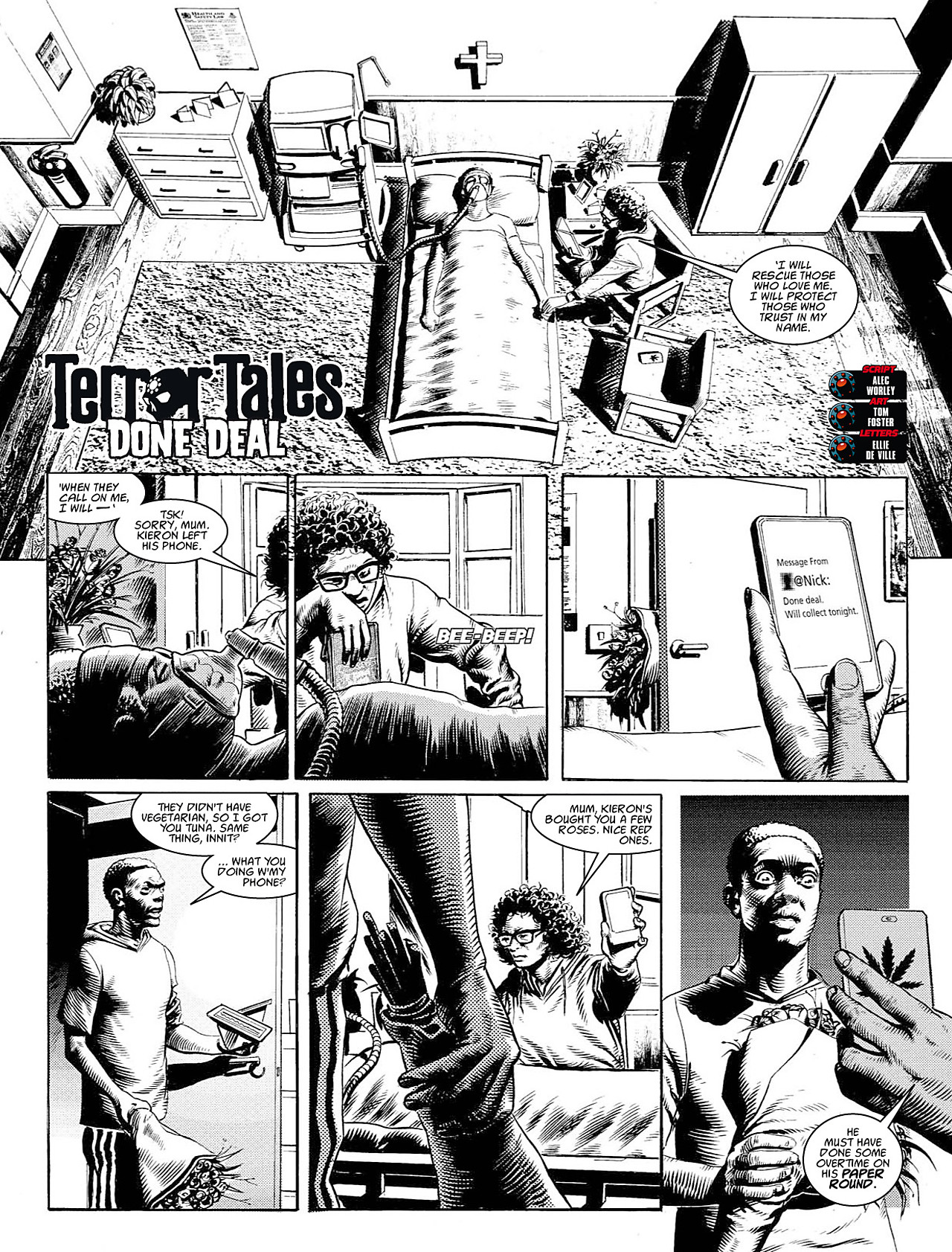
I love this page bud. You are into horror, punk and Alan Grant….we should be mates ha.
I am indeed, which is why when I feel like indulging myself I go reread that Grant comic where RoboCop fights a scary roboticized gorilla during a massive street riot.